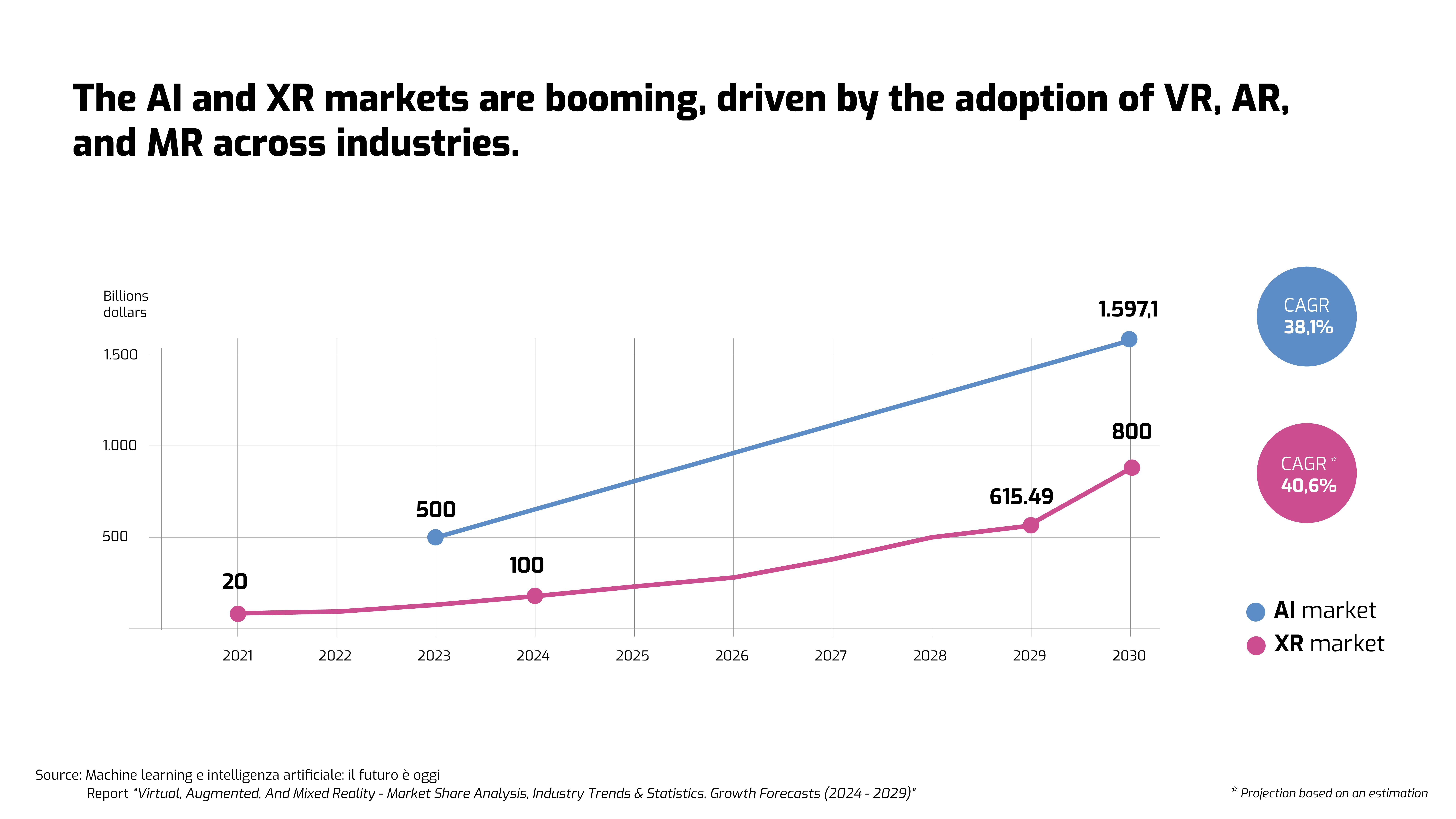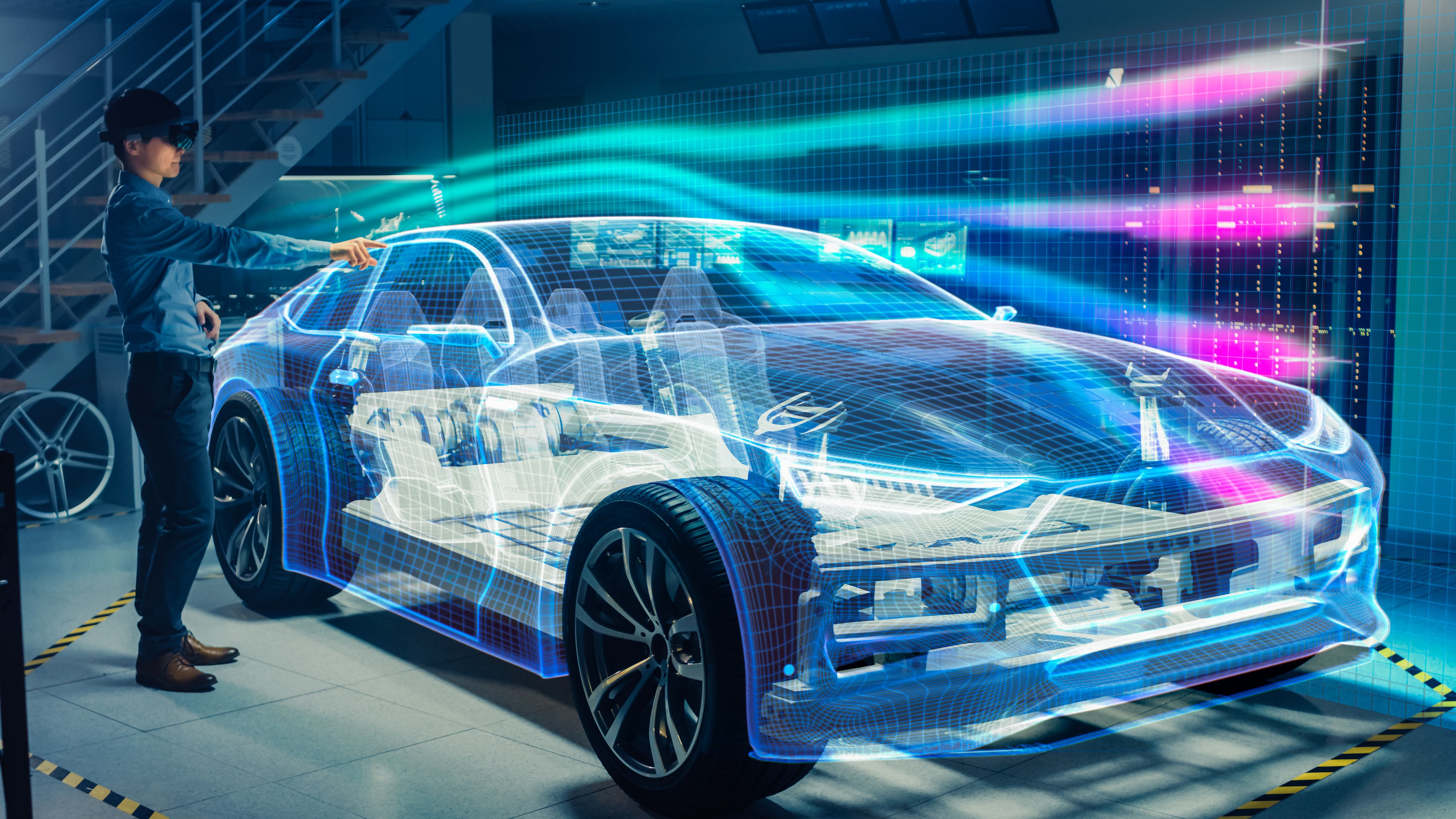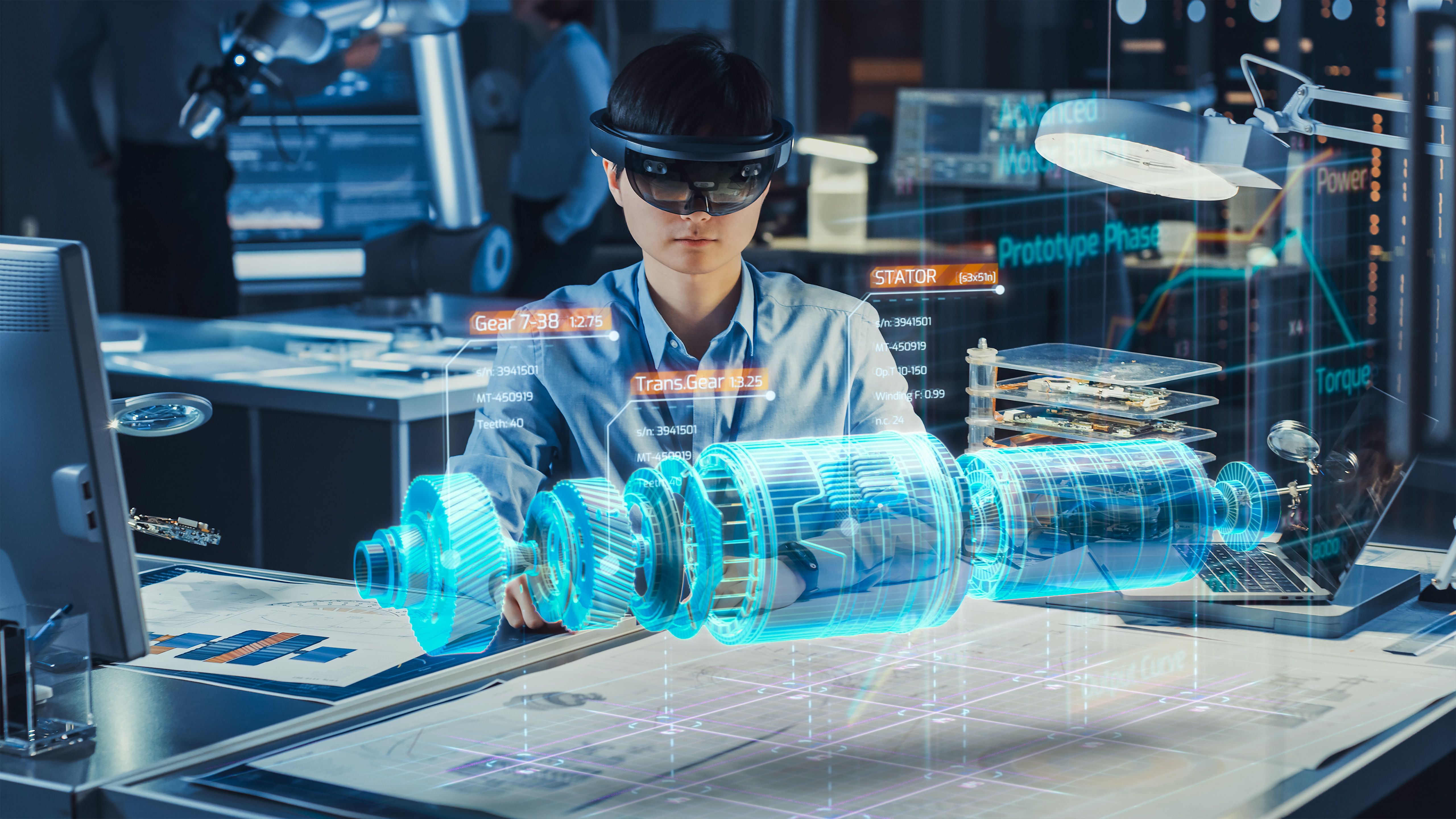The automotive industry is undergoing an unprecedented transformation thanks to emerging technologies like Artificial Intelligence (AI) and Extended Reality (XR). These innovations are converging into SmartXR, an advanced technological ecosystem that enhances design, production, training, and customer experience.
The booming AI & XR markets: why now?
According to market projections, the AI market is expected to reach $1.59 trillion by 2030, with a 38.1% compound annual growth rate (CAGR). Meanwhile, the XR market is projected to grow at an even faster rate of 40.6%, reaching $800 billion (IlSole24Ore, Marketsandmarkets).
The rapid adoption of SmartXR in the automotive sector is driven by several key trends that are shaping the future of the industry. One of the most significant factors is the increasing demand for immersive vehicle design and prototyping. Automakers are leveraging AI-powered XR to create highly detailed virtual models of their vehicles, allowing engineers to test aerodynamics, safety features, and ergonomics long before a physical prototype is built. This not only accelerates the research and development process but also reduces costs and minimizes design errors.
At the same time, predictive maintenance is emerging as a game-changer for manufacturers and fleet operators. By integrating AI and IoT technologies, automotive companies can now analyze real-time data from vehicles to detect potential failures before they occur. This shift towards a proactive maintenance approach significantly reduces downtime and repair costs, ultimately improving operational efficiency.
Another major driver of SmartXR adoption is the evolution of customer experience in the automotive industry. Traditional car-buying journeys are being transformed by AI-powered virtual showrooms, where customers can explore vehicle models, customize features, and even take virtual test drives without stepping into a dealership. This not only enhances engagement but also caters to the growing preference for digital-first purchasing experiences.
Finally, the automotive sector is witnessing a surge in AI-driven training programs designed to upskill technicians and employees. Instead of relying on costly in-person training sessions, companies are using immersive XR simulations to create highly interactive learning environments. This allows technicians to practice repairs and assembly procedures in a risk-free setting, improving accuracy and efficiency while reducing training costs.
As these trends continue to gain momentum, SmartXR is proving to be a fundamental pillar of innovation in the automotive industry, setting new standards for efficiency, sustainability, and customer engagement.
SmartXR: a game-changer for the automotive industry
The integration of AI, XR, and Spatial Computing is transforming multiple aspects of the automotive sector, from design and manufacturing to customer experience and workforce training. By leveraging these technologies, companies can accelerate innovation, reduce costs, and enhance operational efficiency.
1. Smarter design & prototyping with digital twins
One of the most impactful applications of SmartXR in automotive is digital twin technology, which allows manufacturers to create highly detailed virtual replicas of vehicles. These AI-powered models enable engineers to test aerodynamics, safety features, and structural integrity in a fully immersive 3D environment, eliminating the need for costly physical prototypes. This approach not only accelerates research and development but also minimizes design flaws, leading to higher-quality, more efficient vehicles.
2. Predictive maintenance & smart manufacturing
The adoption of AI-driven predictive maintenance is revolutionizing how automotive companies manage vehicle lifecycles. By collecting and analyzing real-time data from embedded sensors, manufacturers and fleet operators can identify potential failures before they happen, reducing unexpected breakdowns and costly repairs. Additionally, Augmented Reality (AR) maintenance guides provide technicians with step-by-step, hands-free instructions, improving repair accuracy and efficiency. In manufacturing, XR-assisted quality control ensures that every vehicle meets the highest standards, optimizing production processes and minimizing defects.
3. Immersive customer experience & AI-Powered showrooms
With consumers demanding more personalized and convenient shopping experiences, automotive brands are turning to AI-powered virtual showrooms. These digital spaces allow buyers to explore, configure, and test vehicles in a fully interactive 3D environment, offering a realistic preview of different models and features without visiting a dealership. AI-powered chatbots and virtual assistants further enhance the experience by answering questions in real time, providing tailored recommendations, and simplifying the decision-making process. This shift towards digital-first engagement is reshaping the automotive retail landscape, making car buying more immersive and accessible.
4. XR-Based training for automotive technicians
Training and workforce development in the automotive industry are also being transformed by SmartXR solutions. Instead of relying on traditional classroom instruction, technicians can now practice repairs and assembly procedures in highly realistic XR simulations. This hands-on, risk-free environment allows employees to develop critical skills faster and with greater precision, leading to higher efficiency and reduced training costs. AI-driven virtual training programs also enable continuous learning, ensuring that workers stay up to date with the latest technologies and best practices
By integrating SmartXR across these key areas, the automotive industry is unlocking new levels of efficiency, safety, and customer engagement. As adoption continues to grow, companies that embrace these innovations will position themselves at the forefront of the next era of mobility.
The challenges of implementing SmartXR – and how to overcome them
Despite its potential, adopting SmartXR in automotive comes with challenges:
🚧 High initial investment – companies must invest in hardware (AR/VR devices) and AI-powered software solutions.
✅ Solution: cloud-based XR platforms and AI-driven modular solutions, like Algho, a Vection Technologies’ solution, reduce upfront costs and improve scalability.
🚧 Integration complexity – SmartXR solutions must work seamlessly with existing ERP, CRM, and CAD systems.
✅ Solution: AI-powered platforms like Vection Technologies' EnWORKS and 3DFrame offer easy plug-and-play integration.
🚧 Workforce adoption resistance – technicians and sales teams may need time to adapt to new XR workflows. ✅ Solution: AI-driven onboarding and training simulations make adoption smoother.
Algho: the conversational AI powering SmartXR in automotive
In the evolving landscape of SmartXR in automotive, one solution that aligns perfectly with this technological revolution is Algho, the conversational AI platform developed by Vection Technologies. Designed to enhance human-machine interaction, Algho brings the power of AI-driven automation to various aspects of the industry, from customer engagement to technical training and after-sales support.
By integrating seamlessly with showrooms and digital platforms, Algho acts as a virtual assistant, guiding customers through vehicle configurations, answering questions in real-time, and offering a more interactive and personalized experience. This AI-powered approach helps businesses streamline the decision-making process and improve customer satisfaction.
Beyond customer service, Algho’s capabilities extend to training and maintenance support. With step-by-step AR instructions, it can assist technicians in performing complex repairs more accurately, reducing errors and increasing efficiency. By facilitating hands-free learning environments, Algho contributes to making training more immersive and cost-effective, helping companies optimize workforce development.
Additionally, in the after-sales phase, Algho provides 24/7 automated assistance, ensuring faster response times and a smoother user experience. Whether it's troubleshooting a technical issue or offering proactive maintenance suggestions, its AI-driven functionalities help enhance service operations and improve overall customer satisfaction.
As SmartXR continues to evolve in the automotive sector, solutions like Algho have the potential to further amplify its impact, offering intelligent automation, improved user experiences, and greater efficiency across different business areas.
Future trends: what’s next for SmartXR in Automotive?
As **SmartXR technology **continues to evolve, its role in the automotive industry is set to expand even further in the coming years. One of the most exciting developments is the use of AI-driven simulations for autonomous vehicle testing. By leveraging XR-powered virtual environments, manufacturers can safely train and refine self-driving algorithms before real-world deployment, reducing risks and accelerating development.
Another key trend is the integration of augmented reality (AR) in in-car systems. Future vehicles will likely feature advanced heads-up displays (HUDs) that overlay navigation, safety alerts, and real-time vehicle diagnostics directly onto the driver’s field of vision. This will not only enhance safety but also improve the overall driving experience by making information more accessible and intuitive.
Meanwhile, the manufacturing side of the industry is also undergoing a transformation. AI-powered robotic assembly lines, combined with XR-assisted quality control, will make production more efficient by reducing errors and optimizing workflows. This will lead to faster turnaround times and improved cost efficiency for automakers.
As the demand for connected, intelligent, and immersive automotive experiences continues to grow, SmartXR will become an essential tool for both manufacturers and consumers. Companies that embrace these technologies early will be better positioned to enhance efficiency, improve safety, and redefine customer interactions in the automotive world.
Want to see Algho in action?
Discover how AI-powered XR solutions can accelerate innovation in your automotive business.




